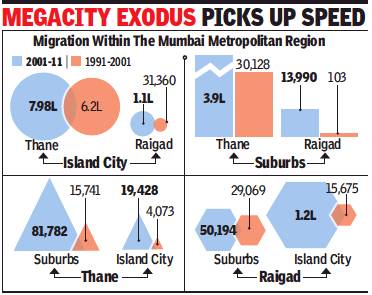Mumbai: migration to, from and within
This is a collection of articles archived for the excellence of their content. |
Migration within the Metropolitan Region
1991-2011
Hemali Chhapia, August 12, 2019: The Times of India

From: Hemali Chhapia, August 12, 2019: The Times of India
Migration from the island city—for long a magnet for migrants and an aspirational destination for the middle classes—has intensified. Over 9 lakh fewer people reside in the island city, reveals a study of the census that shows patterns of migration within the Mumbai Metropolitan Region. On the other hand, Thane’s population went up by 29.3 lakh between the 2001 and 2011 census years. Of this population, about 8 lakh are people who moved out of south Mumbai to settle here.
The last census affirmed that Thane is the focal point of MMR’s population influx. For example, migration from the suburbs to Thane went up ten times, from 30,128 to 3.9 lakh between 2001 and 2011. Counterintuitively, about 1.1 lakh people migrated from the island city to Raigad.
“Nearly half of households reported that the easy availability of homes and better places to stay in comparison to an overcrowded Mumbai city was their reason for moving to Thane. For most, buying a house was out of reach in Mumbai,” said D P Singh, the professor at the Centre for Research Methodology who put together the data.
For example, Siddharth Patil moved out of Worli’s BDD chawls to Kharghar with his family. “My father had a job in a mill. With that gone, we saw no reason to stay in the centre of the city. In fact, who says that the island city is the epicentre now?” Again, for Shanti T, who lived in Matunga in a ‘pagdi’ flat, owing a house of her own was a dream. “I saw an advertisement of a flat that was available in Navi Mumbai. We bought that as an investment initially, but with the improvement in the transport network, decided to move there, our own home, in 2014,” she said.
The central story is the same, says economist Abhay Pethe. “Affordable housing. By selling off a place or an asset that one may have in Mumbai, it only makes sense to take that money and move to a bigger place in Thane. Also, Mumbai was earlier one CBD (central business district). Now there are multiple CBDs. With the hope of connectivity, moving out makes perfect sense as the inconvenience is not so much, but the money involved is large,” explained Pethe. For many, the trend was clear since 2001 as people who wanted to buy homes did so in Vashi, Sanpada and Mira-Bhayandar. Thane’s population explosion, in fact, prompted the administration to slice the district into two.
Next boom could be in Raigad
Hence was born the semiurban township of Palghar, the state’s 36th district. The massive population explosion in the last decade in Thane district tilted the balance of development in favour of the urban talukas of Thane, Kalyan, Ulhasnagar and Bhiwandi. Demographers and urban planners see parts of Raigad as a new promising land. “Panvel, areas like Taloja, are now seeing massive development. The next census will have some interesting points on migration to these locales. The new airport will also tilt people’s preferences towards Panvel,” said Singh.